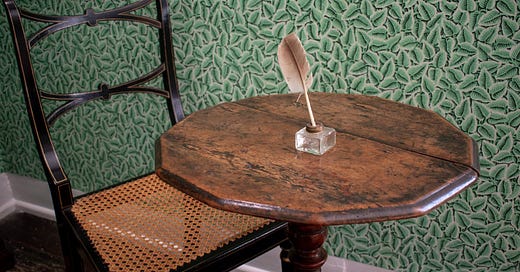Jane Austen's Little Table: A Big Part of Literary History
A confession from my Chawton childhood
Hello my friends,
Of all the treasures on display at Jane Austen's House in Chawton, perhaps none evokes such emotional responses as the small twelve-sided writing table where Jane crafted her most beloved works. As her fifth great-niece who grew up in Chawton, I've witnessed countless visitors standing in awe before this unassuming piece of furniture, tears in their eyes as they contemplate the literary magic that flowed from its surface.
In the pages of my memoir, Jane & Me: My Austen Heritage, I shared countless memories of growing up at Chawton House, but some childhood moments felt too personal (and too embarrassing) to share. But, as we approach Jane's 250th birthday celebrations, I've decided to share a private confession about this historic table that I've kept secret for over four decades. It's a small story of the innocent ways I connected with our family heritage when I was young, without realising the significance of my actions.
But first, a bit of background about Jane’s writing table.
This modest walnut table tells a remarkable story not just of Jane's genius, but of our family's efforts to preserve her legacy across generations.
It's such a small thing, really. Just 47cm wide on its flat edges, with twelve sides and a moulded edge. The top dates from the early eighteenth century, while its base, a single turned column with graceful 's' scroll tripod supports, may be even older, possibly from the seventeenth century.
I am often asked why Jane chose such a tiny table for her monumental work. Perhaps its small, unassuming nature perfectly suited her desire to write quietly and discreetly. As her nephew James Edward Austen-Leigh noted in his Memoir of Jane Austen:
"She was careful that her occupation should not be suspected by servants, or visitors, or any persons beyond her own family party. She wrote upon small sheets of paper which could easily be put away, or covered with a piece of blotting paper."
While James Edward's memoir is an important record from someone who actually knew Jane, I can't help but wonder if he slightly romanticized Jane's secrecy. Though Jane certainly guarded her writing from wider society and unexpected visitors, I find it rather impossible to imagine the servants at Chawton Cottage (as Jane Austen's House was known then) remained unaware of her literary pursuits. The hours of daily writing at her little table by the window, the scratching of her quill, the thoughtful pauses, would have formed a familiar rhythm to those who maintained the household. Perhaps the servants simply honoured her desire for privacy while quietly witnessing the creation of literary history.
Jane was known to be methodical and tidy, needing little space for her work. Given the amount of space I need when I am writing, I find it extraordinary and poetically fitting that from this diminutive surface came such expansive worlds, a physical testament to how Jane's precise, economical prose could conjure entire universes of emotion and social complexity.
Growing up at Chawton House, Jane's writing table was part of the tapestry of my childhood, a tangible connection to our family's most famous member. I watched visitors who had made their pilgrimage to Jane's cottage, just a short walk from our home, often visibly moved by the experience of standing where Jane once stood.
Nothing seemed to affect visitors quite like her writing table, the very surface where her quill touched paper, where the story of Elizabeth Bennet and Mr. Darcy so familiar to us all was prepared for publication, where Emma Woodhouse's matchmaking schemes were devised, where the Dashwood sisters' fortunes were decided, where Anne Elliott's quiet strength and second chance at love blossomed despite the odds against her.
Occasionally, I would sit at this table, imagining Jane by the window (she only had natural light to work with), crafting her remarkable novels. Very occasionally, visitors would spot me there, and I would pose for a photograph as a member of Jane’s family.
Now I must confess my childhood secret, what Jane’s table means to me, and how it was returned to Chawton Cottage 140 years after her death.
Keep reading with a 7-day free trial
Subscribe to Jane Austen's Niece: Caroline Jane Knight to keep reading this post and get 7 days of free access to the full post archives.




